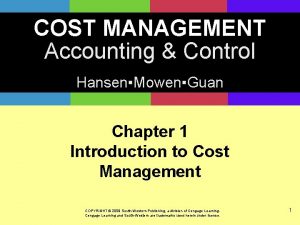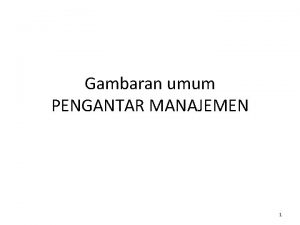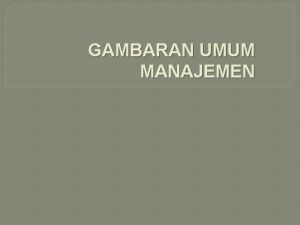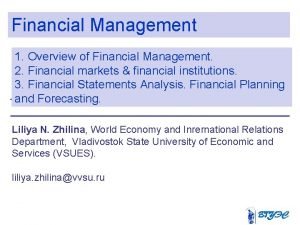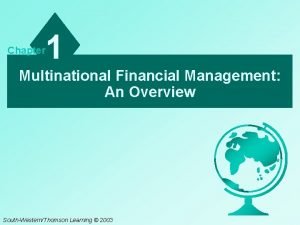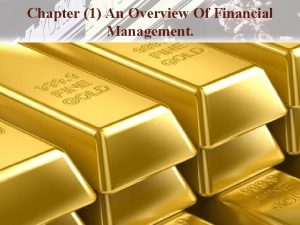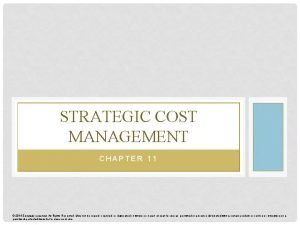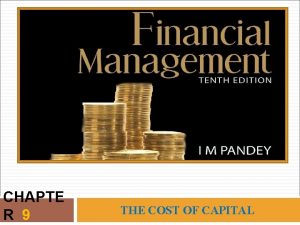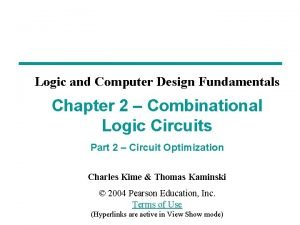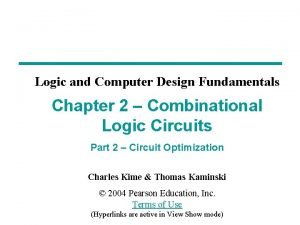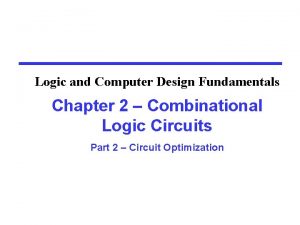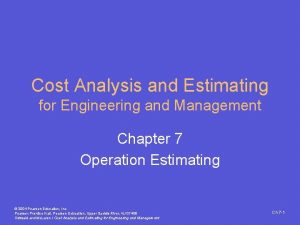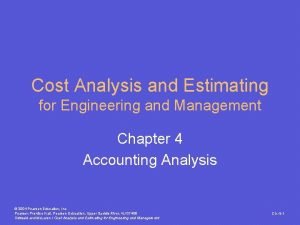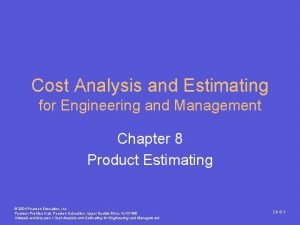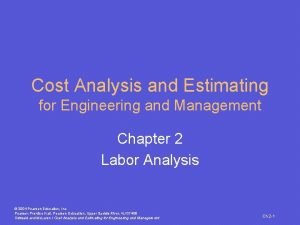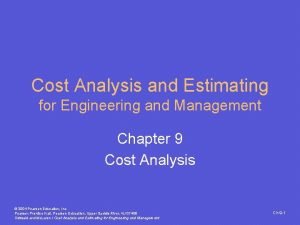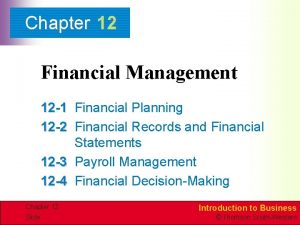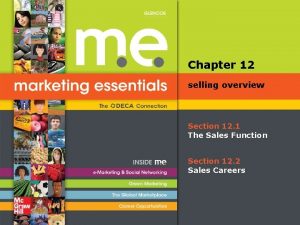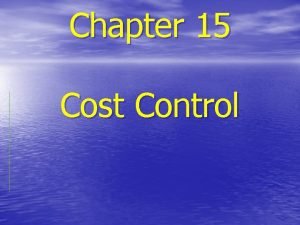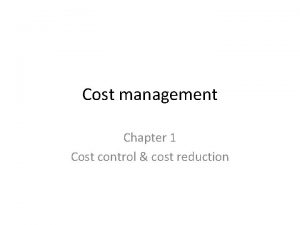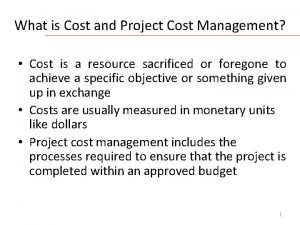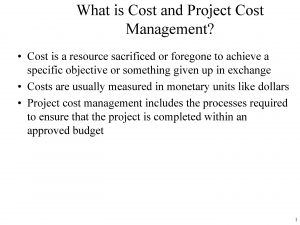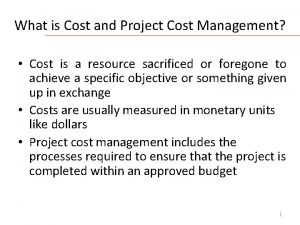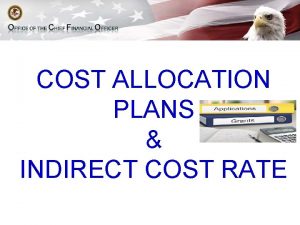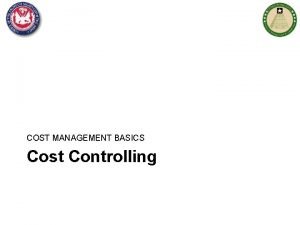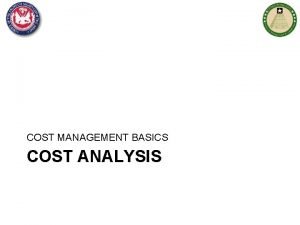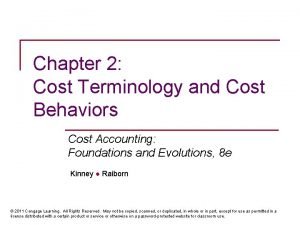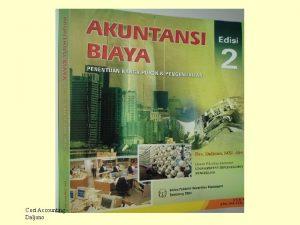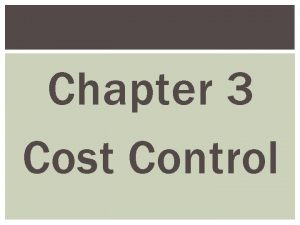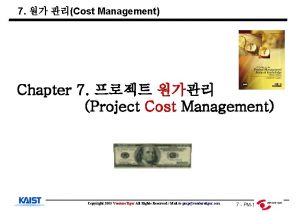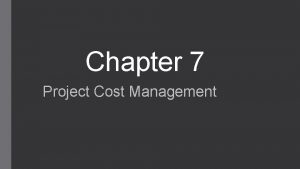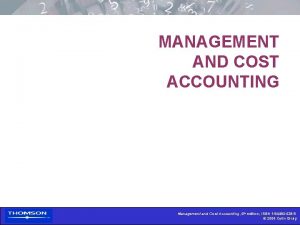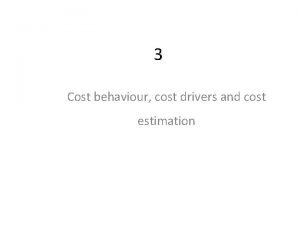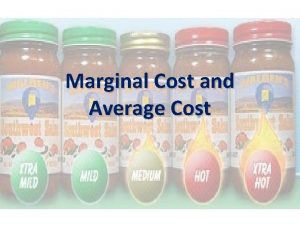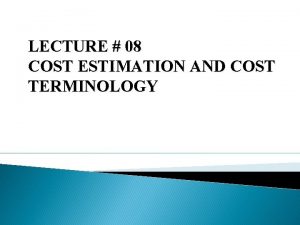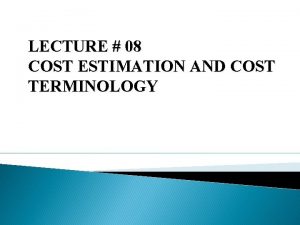Chapter 1 Cost Management and Strategy An Overview



























































- Slides: 59


Chapter 1 Cost Management and Strategy: An Overview

3 Learning Objectives n Explain the use of cost management information in each of the four functions of management n Explain how the contemporary business environment has influenced cost management n Explain the contemporary management techniques and how they have influenced cost management Mc. Graw-Hill/Irwin © 2005 The Mc. Graw-Hill Companies, Inc. , All Rights Reserved.

4 Learning Objectives n Explain the different types of competitive strategies n Describe the professional environment of the management accountant, including professional organizations, professional certifications, and professional ethics n Understand the principles and rules of professional ethics and explain how to apply them Mc. Graw-Hill/Irwin © 2005 The Mc. Graw-Hill Companies, Inc. , All Rights Reserved.

5 Cost Management Information Cost management information is the information that the manager needs to effectively manage the firm or not-for-profit organization and includes both financial information about costs and revenues as well as relevant nonfinancial information about productivity, quality, and other key success factors Mc. Graw-Hill/Irwin © 2005 The Mc. Graw-Hill Companies, Inc. , All Rights Reserved.

6 Management Accountants Management accountants develop cost management information for which a firm’s controller is responsible Mc. Graw-Hill/Irwin © 2005 The Mc. Graw-Hill Companies, Inc. , All Rights Reserved.

7 Typical Organization Chart Chief Executive Officer Chief Financial Officer Vice President for Marketing Vice President for Operations Controller Treasurer Chief Information Officer Cost Management Financial Systems Financial Reporting Other Reporting Obligations Mc. Graw-Hill/Irwin © 2005 The Mc. Graw-Hill Companies, Inc. , All Rights Reserved.

8 Learning Objective One Explain the use of cost management information in each of the four functions of management Mc. Graw-Hill/Irwin © 2005 The Mc. Graw-Hill Companies, Inc. , All Rights Reserved.

9 Four Functions of Management Strategic management Planning and decision making Management and operational control Preparation of financial statements Mc. Graw-Hill/Irwin © 2005 The Mc. Graw-Hill Companies, Inc. , All Rights Reserved.

10 Strategic Management n 1. 2. 3. 4. Strategic management requires: Anticipating changes Understanding the business and competitive environment Ability to make changes quickly Ability to identify and solve problems from a cross-functional view Mc. Graw-Hill/Irwin © 2005 The Mc. Graw-Hill Companies, Inc. , All Rights Reserved.

11 Strategic Cost Management Strategic cost management is the development of cost management information to facilitate the principal management function, strategic management Mc. Graw-Hill/Irwin © 2005 The Mc. Graw-Hill Companies, Inc. , All Rights Reserved.

12 Types of Organizations Manufacturers Merchandisers Wholesalers Mc. Graw-Hill/Irwin Service firms Government and Not-for-profit Retailers © 2005 The Mc. Graw-Hill Companies, Inc. , All Rights Reserved.

13 Learning Objective Two Explain how the contemporary business environment has influenced cost management Mc. Graw-Hill/Irwin © 2005 The Mc. Graw-Hill Companies, Inc. , All Rights Reserved.

14 Changes in Business Environment Increase in global competition Advances in manufacturing technologies Advances in information technologies Social, political, And cultural changes New forms of management organization Greater focus on the customer Mc. Graw-Hill/Irwin © 2005 The Mc. Graw-Hill Companies, Inc. , All Rights Reserved.

15 Global Competition n Business and organization are all significantly affected in by the rapid growth of. Advances incoming interdependence and manufacturing increased competitiontechnologies form other countries n The increasing competitiveness of the global business environment means that firms increasingly need cost management information to be competitive n Firms need financial and nonfinancial information about doing business and competing effectively in other countries Mc. Graw-Hill/Irwin © 2005 The Mc. Graw-Hill Companies, Inc. , All Rights Reserved.

16 Manufacturing Technologies n To remain competitive in the face of the increased global competition, firms around the world are adopting new manufacturing technologies n Many firms are adopting the methods applied in Japanese manufacturing that have produced significant cost and quality improvements Mc. Graw-Hill/Irwin © 2005 The Mc. Graw-Hill Companies, Inc. , All Rights Reserved.

17 Information Technologies n n 1. 2. Perhaps the most fundamental of all business changes in recent years has been the increasing use of information technology Information technologies have fostered the growing strategic focus in cost management by: reducing the time required for processing transactions expanding the individual manager’s access to information with the firm, the industry, and the business environment around the world Mc. Graw-Hill/Irwin © 2005 The Mc. Graw-Hill Companies, Inc. , All Rights Reserved.

18 Greater Focus on the Customer n Producing value for the customer changes the orientation of managers from low-cost production of large quantities to quality, service , timeliness of delivery, and the ability to respond to the customer's desire for specific features n Cost management reports area also changing, as the cost management reports now include specific measure of customer preferences and customer satisfaction Mc. Graw-Hill/Irwin © 2005 The Mc. Graw-Hill Companies, Inc. , All Rights Reserved.

19 Management Organization n The hierarchical command-control type of organization is being replaced by a more flexible organizational form that encourages teamwork and coordination among business functions n Costs management practices are also changing to include reports that are useful to cross-functional teams of managers Mc. Graw-Hill/Irwin © 2005 The Mc. Graw-Hill Companies, Inc. , All Rights Reserved.

Social, Political, & Cultural Considerations n n 1. 2. 3. Significant changes have taken place in the social, political, and cultural environments that affect business Such changes include: a more ethnically and racially diverse workforce a renewed sense of ethical responsibility among mangers and employees an increased deregulation of business by the federal government Mc. Graw-Hill/Irwin 20 © 2005 The Mc. Graw-Hill Companies, Inc. , All Rights Reserved.

21 Comparison of Business Environments Place Exhibit 1. 3 Here Mc. Graw-Hill/Irwin © 2005 The Mc. Graw-Hill Companies, Inc. , All Rights Reserved.

Four Stages in the Development of Cost Management Systems n 1. 2. 3. 4. 22 The phases of the development of cost management systems include: Basic transaction recording systems Focus on external financial reporting Track key operating data and develop more accurate and relevant cost information for decision making Integrate strategically relevant cost management information Mc. Graw-Hill/Irwin © 2005 The Mc. Graw-Hill Companies, Inc. , All Rights Reserved.

23 Critical Success Factors (CSFs) n CFSs are measures of those aspects of the firm’s performance essential to its competitive advantage and therefore to its success n Many of these critical success factors are financial but many are nonfinancial n The CSFs for any given firm depend on the nature of the competition it faces Mc. Graw-Hill/Irwin © 2005 The Mc. Graw-Hill Companies, Inc. , All Rights Reserved.

24 Learning Objective Three Explain the contemporary management techniques and how they have influenced cost management Mc. Graw-Hill/Irwin © 2005 The Mc. Graw-Hill Companies, Inc. , All Rights Reserved.

25 Benchmarking n 1. 2. 3. Benchmarking is a process by which a firm: Identifies it critical success factors Studies the best practices of other firms for achieving these CSFs Implements improvements in the firm’s processes to match or beat the performance of those competitors Mc. Graw-Hill/Irwin © 2005 The Mc. Graw-Hill Companies, Inc. , All Rights Reserved.

26 Total Quality Management Where are we? Benchmarking Do we need to change the plan? Where do we want to go? Plan Act is Check Do How do we start? Continuous Improvement How are we doing? Mc. Graw-Hill/Irwin © 2005 The Mc. Graw-Hill Companies, Inc. , All Rights Reserved.

27 Continuous Improvement n Continuous improvement is a management technique by which managers and workers commit to a program of continuous improvement in qualify and other critical success factors. n Its origin is attributed to Japanese manufacturers who pursue quality n Continuous improvement is often associated with benchmarking and TQM Mc. Graw-Hill/Irwin © 2005 The Mc. Graw-Hill Companies, Inc. , All Rights Reserved.

Activity-Based Costing (ABC) and Management (ABM) 28 n Activity analysis is used to develop a detailed description of the specific activities performed in the firm’s operations n ABC is used to improve the accuracy of costs analysis by improving the tracing of costs to products or to individual customers n ABM is uses activity analysis to improve operational control and management control Mc. Graw-Hill/Irwin © 2005 The Mc. Graw-Hill Companies, Inc. , All Rights Reserved.

Activity-Based Costing (ABC) and Management (ABM) 29 n ABC is a product costing method that is useful in industries where overhead is high relative to other costs n ABC assigns costs based on numerous activity-based allocation bases whereas traditional costing methods normally assign costs on one or two volume-based allocation bases Mc. Graw-Hill/Irwin © 2005 The Mc. Graw-Hill Companies, Inc. , All Rights Reserved.

30 Reengineering n n 1. 2. 3. 4. A business process is diagrammed in detail Every step in the business process must be justified The process is redesigned to include only those steps that make the product more valuable Anticipated results include: Process is simplified Process is completed in less time Costs are reduced Opportunities for errors are reduced Mc. Graw-Hill/Irwin © 2005 The Mc. Graw-Hill Companies, Inc. , All Rights Reserved.

31 Theory of Constraints n Theory of Constraints (TOC) is a strategic technique to help firms effectively improve the rate at which raw materials are converted to finished products n TOC is a sequential process of identifying and removing constraints in a system Mc. Graw-Hill/Irwin © 2005 The Mc. Graw-Hill Companies, Inc. , All Rights Reserved.

32 Mass Customization n Mass customization is a management technique in which marketing and production processes are designed to handle the increased variety that results from delivering customized products and services to customers Mc. Graw-Hill/Irwin © 2005 The Mc. Graw-Hill Companies, Inc. , All Rights Reserved.

33 The Just-in-Time (JIT) System n. A just-in-time (JIT) system is a comprehensive production and inventory management system that purchases or produces materials and parts only as needed and just in time to be used at each stage of the production process n JIT focuses on eliminating waste, reducing inventories, and developing strong supplier relationships Mc. Graw-Hill/Irwin © 2005 The Mc. Graw-Hill Companies, Inc. , All Rights Reserved.

34 The Just-in-Time (JIT) System n JIT manufacturing systems highlight existing problems such as bottlenecks inventory loss, and unreliable suppliers n Kanban is a set of control cards used to signal the need for materials and products to move from one operation to the next in an assembly line Mc. Graw-Hill/Irwin © 2005 The Mc. Graw-Hill Companies, Inc. , All Rights Reserved.

Computer-Aided Design (CAD) and Manufacturing (CAM) 35 n Computer-aided design (CAD) is the use of computers in product development, analysis, and design modifications to improve the quality and performance of the product n Computer-aided manufacturing (CAM) is the use of computers to plan, implement, and control production Mc. Graw-Hill/Irwin © 2005 The Mc. Graw-Hill Companies, Inc. , All Rights Reserved.

36 Automation requires a relatively large investment in computers, computer programming, machines, and equipment n A flexible manufacturing system (FMS) is a computerized network of automated equipment that produces one or more groups of parts or variations of a product in a flexible manner n Computer-integrated manufacturing (CIM) is a manufacturing systems that totally integrates all office and factory functions within a company via a computerbased information network to allow hour-by-hour manufacturing management n Mc. Graw-Hill/Irwin © 2005 The Mc. Graw-Hill Companies, Inc. , All Rights Reserved.

37 Target Costing n Target Costing determines the desired cost for a product on the basis of a given competitive price so that the product will earn a desired profit Target cost = Market-determined price – Desired profit Mc. Graw-Hill/Irwin © 2005 The Mc. Graw-Hill Companies, Inc. , All Rights Reserved.

38 Target Costing Identify product opportunity. Determine price that would make product competitive. Determine if product can be made at cost sufficiently low to provide a desired profit. Mc. Graw-Hill/Irwin © 2005 The Mc. Graw-Hill Companies, Inc. , All Rights Reserved.

39 Life-Cycle Costing n 1. 2. 3. 4. 5. Identify and monitor costs throughout a product’s life cycle Research and Development costs Product design and testing costs Manufacturing, inspecting, packaging and warehousing costs Marketing, promotion, and distribution costs Sales and service costs Mc. Graw-Hill/Irwin © 2005 The Mc. Graw-Hill Companies, Inc. , All Rights Reserved.

40 The Value Chain n n 1. 2. 3. The value chain is an analysis tool firms use to identify the specific steps required to provide a product or service to the customer An analysis of the firm’s value chain helps management discover: which steps or activities are not competitive where costs can be reduced which activity should be outsourced Mc. Graw-Hill/Irwin © 2005 The Mc. Graw-Hill Companies, Inc. , All Rights Reserved.

41 The Balanced Scorecard n 1. 2. 3. 4. The balanced scorecard is an accounting report that includes the firm’s critical success factors in four areas: Financial performance Customer satisfaction Internal business processes Innovation and learning Mc. Graw-Hill/Irwin © 2005 The Mc. Graw-Hill Companies, Inc. , All Rights Reserved.

42 The Balanced Scorecard How do we look to the owners? In which internal business processes must we excel? How can we continually innovate and learn? How do we look to customers? Mc. Graw-Hill/Irwin © 2005 The Mc. Graw-Hill Companies, Inc. , All Rights Reserved.

43 The Balanced Scorecard Learning improves business processes. Improved business processes improve customer satisfaction. Improving customer satisfaction improves financial results. Mc. Graw-Hill/Irwin © 2005 The Mc. Graw-Hill Companies, Inc. , All Rights Reserved.

44 Learning Objective Four Explain the different types of competitive strategies Mc. Graw-Hill/Irwin © 2005 The Mc. Graw-Hill Companies, Inc. , All Rights Reserved.

45 Strategies n. A strategy is a set of policies or procedures to business that produce long-term success n Finding a strategy begins with determining the purpose and long-range direction, and therefore the mission, of the company n The mission is developed into specific performance objectives, which are then implemented by specific corporate strategies, to achieve the objectives that will fulfill the mission Mc. Graw-Hill/Irwin © 2005 The Mc. Graw-Hill Companies, Inc. , All Rights Reserved.

46 Strategic Positioning n 1. 2. Firms arrive at one of two competitive strategies: Cost leadership is a competitive strategy in which a firm succeeds in producing products or services at the lowest cost in the industry Differentiation is a competitive strategy in which a firm succeeds by developing and maintaining a unique value for the product as perceived by consumers Mc. Graw-Hill/Irwin © 2005 The Mc. Graw-Hill Companies, Inc. , All Rights Reserved.

Distinctive Aspects of the Two Competition Strategies 47 Place Exhibit 1. 10 Here Mc. Graw-Hill/Irwin © 2005 The Mc. Graw-Hill Companies, Inc. , All Rights Reserved.

48 Learning Objective Five Describe the professional environment of the management accountant, including professional organizations, professional certifications, and professional ethics Mc. Graw-Hill/Irwin © 2005 The Mc. Graw-Hill Companies, Inc. , All Rights Reserved.

49 Professional Organizations n 1. 2. The professional environment of the management accountant is influenced by two types of organizations: One that set guidelines and regulations regarding management accounting practices One that promotes the professional and competence of management accountants Mc. Graw-Hill/Irwin © 2005 The Mc. Graw-Hill Companies, Inc. , All Rights Reserved.

50 Professional Certifications n n 1. 2. 3. The role of professional certification programs is to provide a distinct measure of experience, training, and performance capability for the management accountant Three types of certification are relevant for management accountants: Certified Management Accountant (CMA) Certified Financial Manager (CFM) Certified Public Accountant (CPA) Mc. Graw-Hill/Irwin © 2005 The Mc. Graw-Hill Companies, Inc. , All Rights Reserved.

51 Professional Ethics n Ethics is an important aspect of the management accountant work and profession n Professional ethics can be summed up as the commitment of the management accountant to provide a useful service for management Mc. Graw-Hill/Irwin © 2005 The Mc. Graw-Hill Companies, Inc. , All Rights Reserved.

52 Learning Objective Six Understand the principles and rules of professional ethics and explain how to apply them Mc. Graw-Hill/Irwin © 2005 The Mc. Graw-Hill Companies, Inc. , All Rights Reserved.

IMA Code of Ethics for Management Accountants 53 Competence Confidentiality Integrity Objectivity Mc. Graw-Hill/Irwin © 2005 The Mc. Graw-Hill Companies, Inc. , All Rights Reserved.

IMA Code of Ethics for Management Accountants 54 Follow applicable laws, regulations and standards. Maintain professional competence. Competence Prepare complete and clear reports after appropriate analysis. Mc. Graw-Hill/Irwin © 2005 The Mc. Graw-Hill Companies, Inc. , All Rights Reserved.

IMA Code of Ethics for Management Accountants 55 Do not disclose confidential information unless legally obligated to do so. Do not use confidential information for personal advantage. Confidentiality Ensure that subordinates do not disclose confidential information. Mc. Graw-Hill/Irwin © 2005 The Mc. Graw-Hill Companies, Inc. , All Rights Reserved.

IMA Code of Ethics for Management Accountants 56 Avoid conflicts of interest and advise others of potential conflicts. Do not subvert organization’s legitimate objectives. Integrity Recognize and communicate personal and professional limitations. Mc. Graw-Hill/Irwin © 2005 The Mc. Graw-Hill Companies, Inc. , All Rights Reserved.

IMA Code of Ethics for Management Accountants 57 Avoid activities that could affect your ability to perform duties. Refrain from activities that could discredit the profession. Integrity Refuse gifts or favors that might influence behavior. Communicate unfavorable as well as favorable information. Mc. Graw-Hill/Irwin © 2005 The Mc. Graw-Hill Companies, Inc. , All Rights Reserved.

IMA Code of Ethics for Management Accountants 58 Communicate information fairly and objectively. Objectivity Disclose all information that might be useful to management. Mc. Graw-Hill/Irwin © 2005 The Mc. Graw-Hill Companies, Inc. , All Rights Reserved.

59 End of Chapter One Mc. Graw-Hill/Irwin © 2005 The Mc. Graw-Hill Companies, Inc. , All Rights Reserved.
 Chapter 1 an overview of financial management
Chapter 1 an overview of financial management Cost management accounting and control
Cost management accounting and control Cost accumulation and cost assignment
Cost accumulation and cost assignment Cost accumulation and cost assignment
Cost accumulation and cost assignment Cost accumulation and cost assignment
Cost accumulation and cost assignment Cost accumulation and cost assignment
Cost accumulation and cost assignment Dennis geyer
Dennis geyer Meaning of
Meaning of Distinguish between average cost and marginal cost
Distinguish between average cost and marginal cost Cost control and cost reduction difference
Cost control and cost reduction difference Job order cost system
Job order cost system Ordering cost and carrying cost
Ordering cost and carrying cost Opportunity costs and trade offs
Opportunity costs and trade offs Cost control and cost reduction project report
Cost control and cost reduction project report Cost control and cost reduction project report
Cost control and cost reduction project report Cost structure refers to the relative proportion of
Cost structure refers to the relative proportion of Chapter 17 overview elements and their properties
Chapter 17 overview elements and their properties Cost management principles
Cost management principles Corporate strategy and business strategy
Corporate strategy and business strategy Chase demand example
Chase demand example Content management system database
Content management system database Nature of hrm
Nature of hrm Project management topics
Project management topics Objective of gym management system
Objective of gym management system Real-time interaction management vendors
Real-time interaction management vendors Management overview
Management overview Management overview
Management overview Overview of financial management
Overview of financial management What is multinational financial management
What is multinational financial management An overview of financial management
An overview of financial management Chapter 11 strategic cost management
Chapter 11 strategic cost management Strategic cost management chapter 1
Strategic cost management chapter 1 Manufacturing cost vs non manufacturing cost
Manufacturing cost vs non manufacturing cost Job costing vs process costing
Job costing vs process costing Flotation cost in cost of equity
Flotation cost in cost of equity Uncontrollable cost example
Uncontrollable cost example Manufacturing cost vs non manufacturing cost
Manufacturing cost vs non manufacturing cost Material price variance
Material price variance Opportunity cost of equity capital
Opportunity cost of equity capital Literal cost gate input cost
Literal cost gate input cost Literal cost gate input cost
Literal cost gate input cost Literal cost gate input cost
Literal cost gate input cost Cost analysis and estimating for engineering and management
Cost analysis and estimating for engineering and management Cost analysis and estimating for engineering and management
Cost analysis and estimating for engineering and management Cost analysis and estimating for engineering and management
Cost analysis and estimating for engineering and management Cost analysis and estimating for engineering and management
Cost analysis and estimating for engineering and management Cost analysis and estimating for engineering and management
Cost analysis and estimating for engineering and management Chapter 12 money management strategy answers
Chapter 12 money management strategy answers A 23 year old male experienced severe head trauma
A 23 year old male experienced severe head trauma Emt chapter 14 medical overview
Emt chapter 14 medical overview Chapter 9 lesson 2 photosynthesis an overview
Chapter 9 lesson 2 photosynthesis an overview Chapter 12 selling overview
Chapter 12 selling overview Chapter 2 an overview of the financial system
Chapter 2 an overview of the financial system Chapter 1 overview of verb tenses
Chapter 1 overview of verb tenses Overview of personal finance chapter 1
Overview of personal finance chapter 1 Mesioclusion
Mesioclusion Chapter 1 review personal finance
Chapter 1 review personal finance Chapter 32 an overview of animal diversity
Chapter 32 an overview of animal diversity Chapter 1 overview of financial statement analysis
Chapter 1 overview of financial statement analysis Cost leadership strategy
Cost leadership strategy

